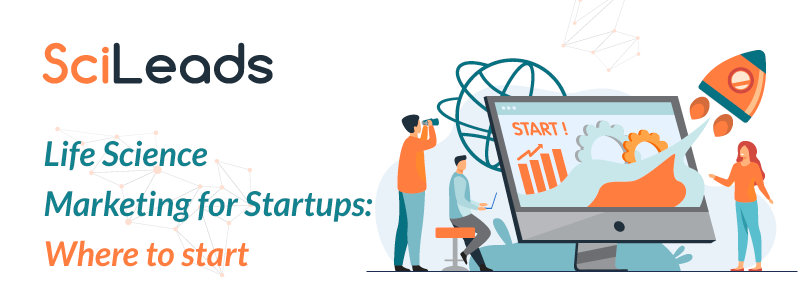For startups and small companies wanting to drive growth through a marketing function, 3 resources tend to be in short supply – money, time, and talent.
The challenge for any company is to find potential customers quickly, but for companies starting out this often has to be done with limited means and marketing awareness. The life science sector is a niche area covering pharma, biotech, and devices, and it can be difficult to know how best to target scientists, what channels work best, and how to gain a good Return on Investment (ROI) from your efforts. Researching life science professionals can become a very manual and time-consuming process that small businesses cannot spare, and if you are not able to hire a dedicated marketing professional, a lot of the work has to be done in-house.
The SciLeads team thrives on supporting life science companies through their growth strategy, so we have outlined a quick guide to marketing for startups and SMEs.
Wait, do we really need more marketing?
Yes, is the simple answer. Sometimes marketing is seen as a luxury rather than a necessity, but it can massively help the sales performance and is important in every size of business. Although startups will already be doing some content marketing such as posting on social media, it is important to consider what the entire marketing function means for your company. Marketing is not just simple advertising and branding, it is everything within your growth strategy and covers pricing, messaging, product positioning, design, PR… the list goes on. It encompasses all aspects of the customer lifecycle in attracting, acquiring, and retaining customers. For your business to thrive, both today and in the future, it’s imperative your organizational chart is built for growth.
How can you make sure your company is built for the future of marketing? Start planning now to determine:
- What skills will you need and who has those skills
- How will you organize your team for maximum efficiency and success
- What tools and software do you need to keep everyone in sync
In startups and small businesses when money and available talent is limited, there might only be one or two people tackling the marketing output but they may also have other responsibilities. Many marketing functions can be outsourced and it is beneficial to create a good working relationship with agencies until you can hire a dedicated marketing person or team.
Hiring someone with industry knowledge would be a great advantage in terms of bringing this person up to speed. However, investing time into creating a solid overview of the company and industry will pay off for employees who are new to the sector. This diagram shows how the marketing function can work in smaller companies:
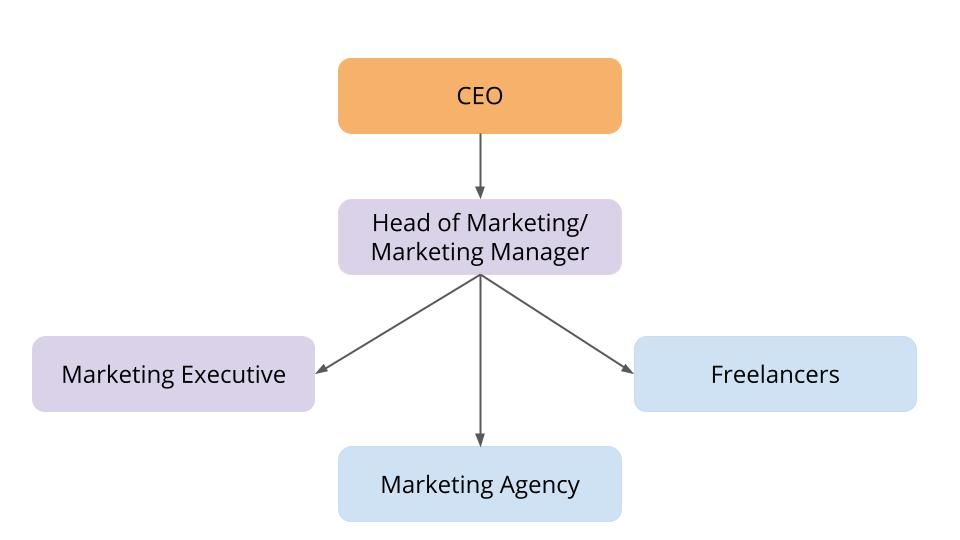
For small companies tackling their marketing inhouse, there are 5 areas that need to be covered:
- Content Creation: updating website content, writing blog posts, use cases, case studies, sales collateral, creating engaging social media posts, brochures and leads magnets, email campaigns, and so on.
- Graphic Design: having a basic working knowledge of Photoshop would be highly desirable, but design apps like Canva are a good substitute.
- Technical Knowledge: having an understanding of SEO concepts is essential. As is a general ability to use software such as a website content management system (CMS) like WordPress, knowing about marketing automation, PPC, and anything else that is digital.
- Social Media: knowledge of social media platforms and management is highly desirable as is using scheduling tools which automates posting across all the channels.
- Project Management: someone needs to oversee the marketing to keep everything on track.
As the company grows, the marketing department can expand to have specialists in areas such as design, content, and PPC as this diagram shows:
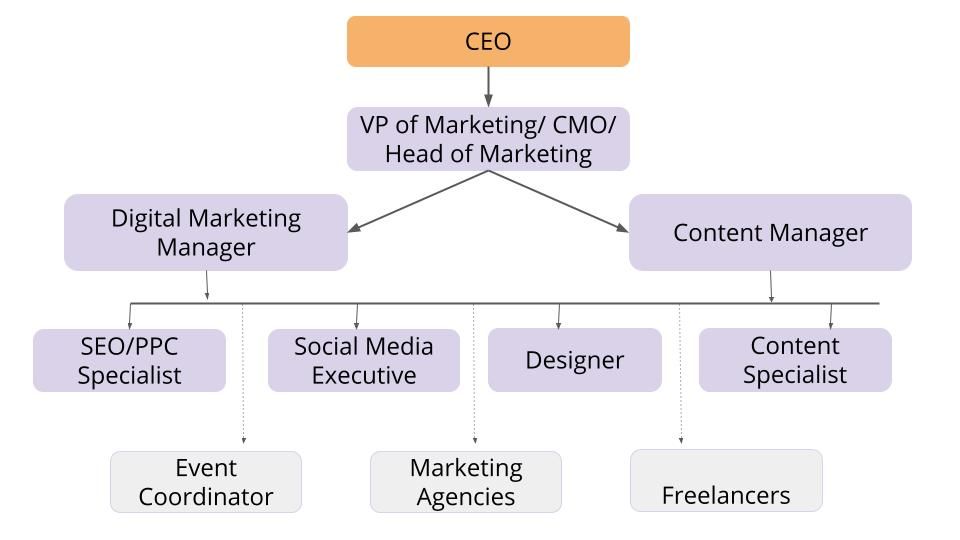
Or even have dedicated Demand Generation and Customer Success roles/teams.
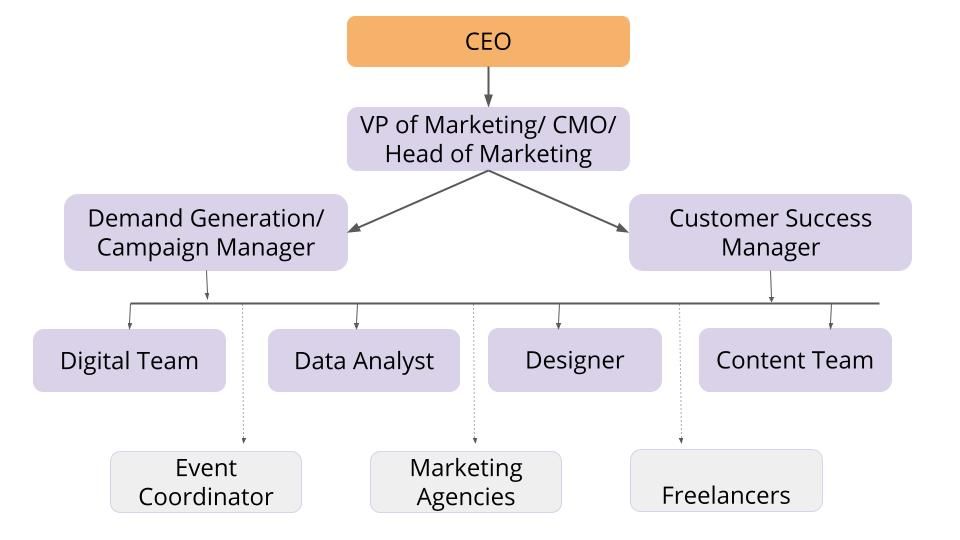
Tip: Define what marketing function you need in the business, and what are your goals – don’t be afraid to outsource the work if you can afford it. There are a number of great marketing agencies in the Life Science industry, many of which we partner with.
Fail to plan, plan to fail
Planning is essential when it comes to marketing. It can be tempting to fire out some posts on social media or send an email to your database, but without a defined strategy of what you are trying to achieve and how, then you are unlikely to achieve good results. A marketing plan setting the parameters of what you want to achieve and how is the key to effectively and affordably finding your buyers.
‘While no one can guarantee your success, having a plan dramatically increases your probability of success. The Pareto Principle predicts that 80% of effects come from 20% of causes. By far the biggest leverage point in any business is marketing. If you get 10% better at marketing, this can have an exponential or multiplying effect on the bottom line.’ (The 1-Page Marketing Plan)
The 1-Page Marketing Plan by Alan Dib is a very helpful template for small businesses to aid ‘direct response marketing’ – a method of evoking an immediate action such as opting-in to your email list, calling for more information, going to your website, or purchasing your product.
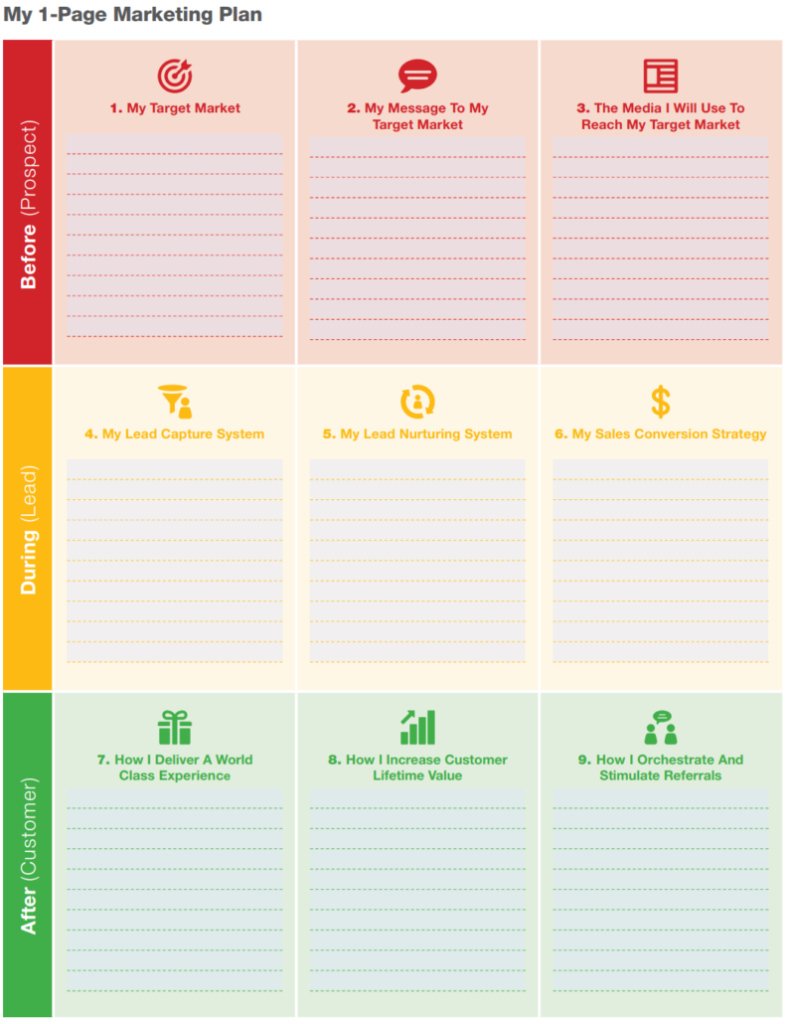
This plan is designed to support each phase of the process ‘before, during, and after’ as people move through the sales journey from prospect to lead to customer. The goal of each is stage is to get them to first know you, then like you, and finally trust you so they buy from you again and again.
The budget is of course a massive consideration for startups and small businesses and so you need to decide how much you can afford to spend and where your money is best invested. It is therefore important to monitor how well your marketing money is spent and what the ROI is. By tracking how well your marketing methods are going, you can see where your money is best placed and where to focus your efforts going forward.
It isn’t necessary to spend a fortune on paid advertising like Google ads and promoted social media content. Particularly because targeting life science audiences through pay-per-click ads can be challenging, as relevant search terms often have low search volume. But by monitoring how well your marketing strategy does you can tell whether paid or organic means work best.
Consider the 5 W’s
When accelerating your marketing efforts it is useful to remember these 5 W’s – Who, What, Where, When, and Why.
Who is your target audience?
By mapping out the profile of your target customer, called a customer or buyer persona, you can focus your research and marketing campaigns on the area that will bring you the most success. When companies start out they have a good idea of who their target market is, but once you have closed a number of deals you can analyze the specific persona in more detail and use this information to target that group specifically in future marketing efforts. Discover more about the importance of understanding your customer here.
‘NetProspex published a case study reporting that its target persona creation efforts led to a doubling of the number of page views per visit, a 900% increase in site visit duration, and a 171% spike in marketing ROI.
The SciLeads platform is very effective for researching and pinpointing your customer persona as you can see the type of people who have purchased similar products to yours, or the type of researcher who has just received funding in a particular area. We also automatically email you new funding in your area of interest biweekly.
Tip: Mapping your buyer persona(s) can be done with a table that includes the job title, what their pain point is, how your company solves it, what their alternative solution is if they don’t use your product/service, and why your product/service can meet their needs.
What are you wanting to achieve?
As start-ups are largely concerned with their growth strategy, it is, therefore, important to define your macro and micro goals and what you want to achieve from your marketing efforts. Make a list of your OKR (Objectives and Key Results) such as increase your website traffic by X%, increase the database by X people, and gain X number of new social media followers each month, and then track how this translates into the number of leads the traffic generated, what the conversion to demos/strong sales engagements is. You want to show how your efforts have been reflected in the revenue. These OKRs will be used to judge whether your marketing strategy is working.
Tip: For more information on OKRs, the book ‘Measure What Matters’ is a very useful resource for tackling your goal-setting and making tough choices in business. It is a simple tool to create alignment and engagement around measurable goals.
Where will you do your marketing?
Before you create your marketing channels, first set up an operational infrastructure with marketing technology (martech) to help support your marketing efforts. These technologies should all integrate and work with each other.
Two key elements in the tech stack are the website and Customer Relationship Management (CRM) software. A website acts as a digital shopfront to houses all the information about your company and its product/services, and the CRM holds all the contact data about your customers and their interaction with your business.
This diagram shows the basic relationship between marketing tools and channels:
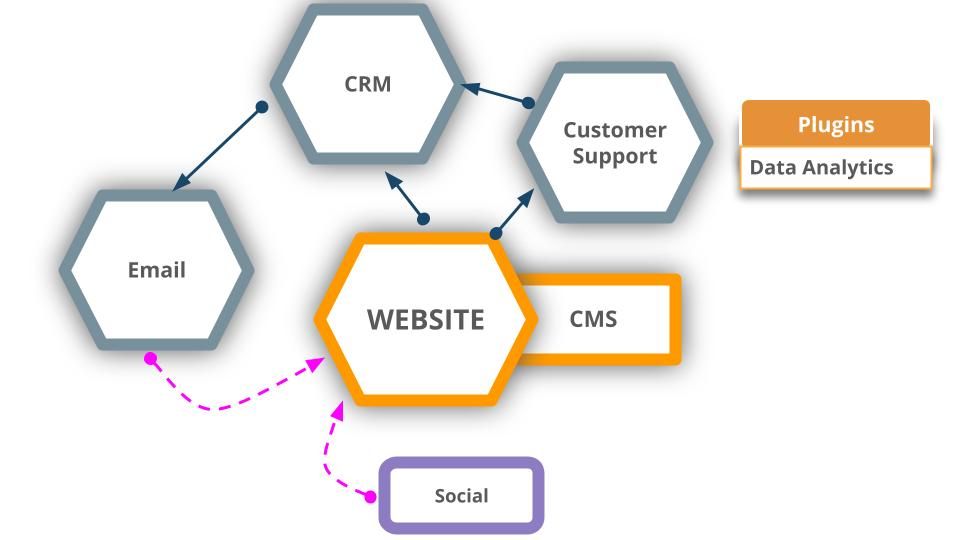
Website
Not all companies have one but it is very helpful for selling your services, building credibility and acting as a helpful hub for all your customer needs. Your website should act as the center for all information on your product/service and be the portal in which people can contact you easily. For start-ups and SMEs, the website doesn’t need to be overly extensive but should have clear messaging targeted to your buyer persona and offer an easy way for customers to reach you.
Search Engine Optimisation (SEO) is a powerful approach when it comes to marketing your website. It can seem like a daunting task for new businesses, but really its purpose is to ensure you achieve maximum visibility online. By including the keywords and search terms in your website content that people would use to find the product/service you are selling, this will help search engines like Google and Bing to list your company and bring inbound leads straight to you. There are lots of free online tools that can help you with your keyword search and SEO.
Your website is also where you keep engaging and useful resources such as your blog, downloads, and event/webinar invites. It is highly beneficial to have a CRM attached to your website to track visitor’s interaction with your content and capture their data for use in email marketing campaigns.
Tip: Data is what drives effective marketing programs, whether that’s keyword tracking, conversion rates, click rates, open rates, report downloads, or social media engagement. This will help you focus your marketing efforts more effectively. Read more about the importance of data-driven marketing here.
CRM
Having a CRM allows you to capture all of the data you have about your life science customers in one place. It also enables you to track deals and analyze the behavior of your audience, as well as give insight into how well sales and marketing are doing. There are plenty of free CRM packages on the market which offer subscription levels and more features as your business grows. You can also find CRMs that have inbuilt email sending and social media posting functionality so that you don’t necessarily need to have multiple software subscriptions. The SciLeads platform now integrates with the Salesforce CRM to provide 360 information on leads and customers, helping to boost sales and marketing efforts further.
Marketing channels such as email and social media should be used to connect with your audience, build brand awareness and credibility and drive customers to your website to help to move them through the sales funnel.
Sending emails is still the most popular way companies contact their customers and nurture leads through the sales pipeline. It is therefore important to have a strategy for contacting your database regularly via email, but you shouldn’t send everyone the same message. Make sure you segment your audience and send your customers one message, and your leads another. Customers should be notified of great updates to your product/service, whereas leads should hear more about the use cases and benefits of what you are selling. Read more about how to send great email messages in our blog 3 email marketing mistakes to avoid.
Tip: There are many free and paid tools for email marketing such as Mailchimp and Sendinblue, but also many CRMs like Hubspot and Zoho have this feature inbuilt.
Social Media
Social media is a great way to talk to your customers directly and gives you the unique opportunity to build relationships with potential customers all over the world in a more informal way. It can be a place where you give the latest updates on your products, post blogs and event invites, as well as gain more insight into your potential customers. By utilizing hashtags you can increase the reach and potential engagement of your content.
There are also paid options in social media that can be relatively good value depending on the channel. This enables you to target a wider but more specific audience by refining your reach by job role, region, company, and other specific parameters.
Tip: Pick the best social media channel for your target customer. In life sciences it is more likely that your leads will be more active on the B2B channels LinkedIn or Twitter rather than B2C channels like Instagram and Facebook, so target your efforts there.
Remember that social media should be just that – social. It is important to try and start two-way conversations with your audience as this boosts engagement and ensures the algorithm shows more people outside of your network your posts.
Events
In the life science industry, events such as trade shows and conferences are an integral part of the marketing and sales program. They enable you to market and sell your product to a targeted audience, as well as examine the competition. They act as a useful means for engaging with existing and potential customers and gaining valuable insights into what content they read, what webinars they find interesting, and even what marketing tactics they tend to ignore.
Using the SciLeads platform you can see what events your leads and customers have attended in the past and use this information to reach out or even arrange future meetings in person (once live events are up and running again).
As your business grows you can utilize the many great marketing digital tools and channels to be more effective and productive. Check out some great productivity tools here.
This diagram shows how your martech stack can grow to support your business:
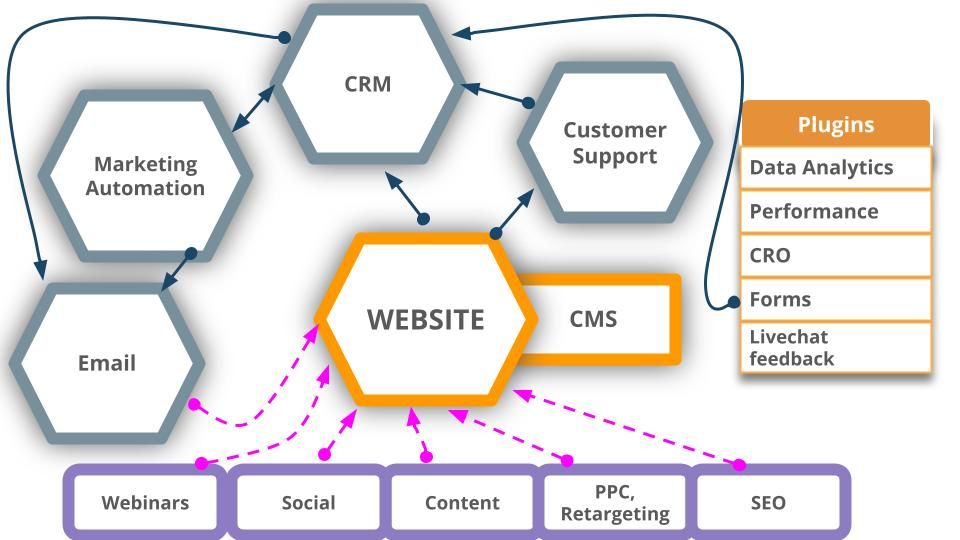
WHEN SHOULD YOU REACH OUT?
Regular content marketing isn’t always possible for startups and small businesses, but again it is important to have a plan. Content marketing first needs an audience, but once you start filling up your database it is a good idea to reach out to them regularly depending on what stage they are in their purchasing journey. Here are three types of content used:
- Lifecycle communications based on where the customer is in their buying journey such as offering a free trial ( if applicable). This can be automated or executed by sales and marketing teams depending on the product/service offered.
- Campaign communications based on specific things you want to target. For example, lead generation for a certain territory, product, or customer cross-sell/up-sell, or new product launches.
- Generic content focused on brand awareness and engagement, or product updates in the form of a newsletter.
Again even if you can’t reach out regularly, having a content plan within the overall marketing plan is important.
Tip: Create a content calendar and plan ahead what will be created and shared, why, and on what channels. Make a note of any upcoming awareness days relevant to your company and that might be of interest to life science professionals as this is a great opportunity to show your audience another side to your business.
Using the SciLeads platform you can target your campaigns for maximum impact, even if you can’t contact potential leads regularly. For example, the funding search feature allows you to see what stage a researcher is in their funding cycle so you can message them at the appropriate time. Or you can use the trade show attendance records to see how active a lead is at certain events and what they are interested in to create more targeted messaging. Or see their upcoming event attendance so you can even arrange a face-to-face meeting.
Why is your company unique?
Whether you are marketing pharmaceuticals or lab equipment, consumables, high-end microscopes, mass spectrometers, DNA sequencers, or research services, you want to stand out from the competition. Market research and competitor analysis is a very important element of marketing so you can sure that the life science professionals and scientists in your niche take notice of your company over others.
Tip: Your product positioning is key. If you want to nail your product positioning game read ‘Obviously Awesome: How to Nail Product Positioning so Customers Get It, Buy It, Love It’ by April Dunford.
You Unique Selling Point (USP) should then be a key feature in your marketing messaging. With the SciLeads platform, you can gain great competitor insight by using the purchasing feature. If you are selling a microscope, for example, you can see who has purchased a similar product and use that information to inform your campaigns. If your microscope has better features or is cheaper than the ones other companies have bought then you can use this information in your sales and marketing messages.
Key takeaways
Fail to plan, plan to fail
It can be exciting to start a company and then want to shout about it from the rooftops (or online in this case) but without a marketing plan, you could be wasting your time and money by not refining your approach. This can lead to inconsistent messaging which confuses customers rather than entices them. Plus without tracking your approach, you won’t know what is going well and where to keep investing.
Don’t blow your budget
When you are seeking impressions, website traffic, followers, and leads, there are so many ways to spend your money, but there are also many free resources available. Don’t feel you have to spend a lot of money on many different marketing tools, start with the basics and go from there. Also, consider investing in lead generation technology such as SciLeads, can give you an immediate advantage on the market and help sell your product so you can start building marketing and other business functions gradually.
It’s ok to get outside help
There are a number of great partners out there to suit all budgets that help startups and small companies grow their marketing capabilities. There are also a number of software tools to supercharge your marketing and lead generation capabilities. There are also organizations like SAMPs (Sales & Marketing Professionals in Science) of which our Co-Founder, Laura Haldane, is an active member. This group connects and empowers people working in sales and marketing for the life science industry and hosts helpful webinars and events.
How SciLeads can help
The Scileads platform has thousands of data sources aggregated together to bring more global life science profiles than you can find anywhere else. The platform is an invaluable resource for startups and small companies as it cuts down research time dramatically as the information is all in one place in a searchable database. Create buyer personas, conduct market research, access purchase data to monitor your competitor’s performance and sales, and locate your target customers quickly and easily. Get a demo and trial now with a sample data list to use in your marketing.


